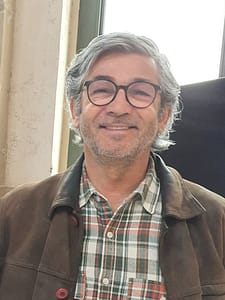Here is the second part of the report from this year’s Vella Terra. We leave Spain, crosses over to Portugal, then from France and to the east, then to the north of Europe.
Fernando Paiva came with his grandson João Goucha, who studies enology in Vila Real. Fernando’s estate Quinta da Palmirinha is in Lixa, south in the Vinho Verde. He is a pioneer in biodynamic farming in Portugal, uses chamomile flowers to avoid the use of sulphur in his natural wines – and is well covered in this blog. (Read about a visit to the estate here.) His Azal and Loureiro varitals were typical and up to standard. Leviano was made for the first time in 2020, that I tasted in Porto last summer. It’s a loureiro, now in the 2021 vintage, made with 3 months skin-contact. This makes it an orange wine, or “curtimento” in Portugal. Golden to orange; aroma of ginger and flowers; full in the mouth with some structure, and a super, integrated acidity.
João Tavares da Pina is found in Penalva do Castelo in Dão. (Read here about a visit to his estate.) The family’s Quinta da Boavista dates back to 1650 and is found at an altitude of 550 meters on deep granite, quartz, clay and shale soils. These vineyards are ideal for grapes like touriga nacional, alfrocheiro and rufete. And not least for the variety jaén (mencía), a speciality of the quinta.
I love his series Rufia (meaning punk), young, fresh wines. Among those tasted this time, why not mention the Rosé 2020, from rufete, touriga and jaen. Salmon-coloured, with raspberry and wild berries, rounded with a very careful tannin. Very interesting was his Tretas 2020, a jaen and touriga nacional. It was macerated on the skins for 4 days and kept in inox for 6 months before bottling (unfiltered, unfined). Tretas means bullshit in local slang. The wine is serious fun: A quaffable glou-glou, but with depth; cherry red, ripe red fruits and with some structure.
I hadn’t met Rodrigo Melo before, but I understand that this is a producer to watch. Rodrigo is from Brazil, but worked for many years in natural wine distribution in London. In 2018 he started his own project and came to Portugal, where he already knew its terroirs and grapes. He bought 4 hectares of land with 30-year-old vines with organic certification in northern Lisboa, that is Quinta da Ermegeira. He also works with biodynamic techniques, and the winemaking is with very low intervention.
Rodrigo showed interesting samples under the label Selva. Noiva 2021 was a different chardonnay, with botrytis and with some residual sugar. Here we chose Cristovan 2020. It is an orange wine (in Portuguese curtimenta) made from arinto, in a cement tank of 1.700 liters. The colour is light orange after 10 days fermentation on skins, the fruit is lovely and the acidity is refreshing. Only 11% alcohol.
Domaine Balansa is a 15-hectare estate in Corbières, established in 2015. This family project has an organic approach to farming and also runs tourism activities in the most sustainable way possible. I tasted the whole portfolio, various styles from southern French grapes. This time we could maybe focus on one of the more “serious” wines, Can del Rey 2020 from Fitou. It’s made from carignan and grenache, from 100 year old vines on hillsides, made with some carbonic maceration and matured some months in oak. It’s dark in colour, with youngish blue; aroma of wild berries, some balsamic, and slight hint of toffee too; good weight, fine tannins and with a balancing acidity.
The Les Vins Pirouettes label covers seventeen independent Alsatian winegrowers committed to organic and biodynamic farming. Each viticulturist grows the grapes on his own land and makes the wine in his own cellar. It’s an initiative by Christian Binner, and the idea was to give the growers a helping hand so that they didn’t need to sell their grapes to cooperatives.
Many times I have been impressed by the energy and creativity behind the wines and the dedication behind the labels. In spite of this, it can be (for me) many new wines each time. As a general rule, we can say that they are affordable natural wines.
Among the most rewarding wines this time was Saveurs 2018 from producer Rafaël, a fruity, citrussy and juicy silvaner (this label also covers a blend). More slender, but equally energetic was David‘s Riesling Glou-Glous 2018, a fresh appley, citrussy wine. There was also a delicious orange gewürztraminer from Franck, L’Étalon 2019. After 10 days of skin-contact it was only light orange, with apples, pears and a (pleasant) vinegary bitterness towards the end.
Foradori of Trentino has been covered many times on this blog, so feel free to search for it all. (Here is a recent post.) Elisabetta Foradori. Earlier I have met her sons, but this was the first time that I have met the beautiful Elisabetta Foradori herself. At a young age she did remarkable work in cultivating organically, later implementing biodynamic methods, and caring for the native varieties of her area, especially the near-extinct teroldego.
I didn’t taste many wines this time, only some whites, like the all-time favourite Nosiola. I also got the chance to be reminded how good was the Fuoripista Pinot Grigio, now in its 2016 vintage. Grown in sandy limestone, it’s fermented 8 months on skins and further aged in Spanish tinajas (amphoras) for 5 month. It has a reddish hue, is flowery with red berries and herbs, and has a concentrated yet smooth appearance in the mouth.
About Carussin of Piemonte I could say the reverse (than Foradori), earlier I have only met the mother Bruna Ferro Carussin. This time I got the opportunity to greet her son Luca Carussin Garberoglio. It’s a winery that I know well from the Norwegian market, and their economic barbera Asinoi has been a house wine in my house for a long time now. Here I tasted a few wines, among them Tra L’Altro 2020, an inspiring, flowery, dry moscato/cortese. Lia Ví 2017, is a superb wine, a single parcel barbera harvested later than others. It’s made from a 35-year-old vineyard planted by Luca’s grandfather, on the sandy soil just in front of the winery. It’s a concentrated wine that shows that barbera also can do with some structure. Elegant aroma, cool fruits (cherry), herbs and flowers, and a concentrate taste with fine tannins and lovely integrated acidity. And it’s not expensive.
Over to Argentina: Stella Crinita is the natural wine project of Joana Foster and Ernesto Catena in Vista Flores de Tunuyán, Valle de Uco. The Catena family is indeed an important one in the history of Argentine wine, having been responsible for bringing the malbec variety to America, as the story goes.
All fermentations are spontaneous, no SO2 added at any stage, nothing fined nor filtered. These are some keywords. The vineyard has been biodynamic certified since 2012. The soils are sandy and clayey and located at 1,100 meters above sea level.
I tasted interesting pét nats and reds from a.o. malbec, syrah, cabernet sauvignon, and a varietal barbera. Petit verdot can be one-dimensional and dull. Their Petit Verdot 2020 was not. On the contrary this single-vineyard biodynamic wine was a linear, long and quite elegant wine from this somewhat difficult grape. Cherry red, plums and blackberries with spice (nutmeg), fine tannins, fresh fruit (cherry) and also a touch of wood and leathertones.
It was also here I had to travel to meet Martin Bech-Ravn, a Danish cider producer, home brewer and artist based in Ekeberg, a neighbourhood in Oslo, Norway. This is a wine blog visiting a wine fair. But when Bech-Ravn in Solhøi Cider talks, then the analogue to wine is striking. For example, he uses one variety of apples to give fullness, another to give acidity. He operates naturally, without additives. He makes Floating Sunshine, Flytende Solskinn 2020, a dry, fresh, flowery, lightly spicy cider bottled unfiltered – in Oslo.
Leave a Comment


































